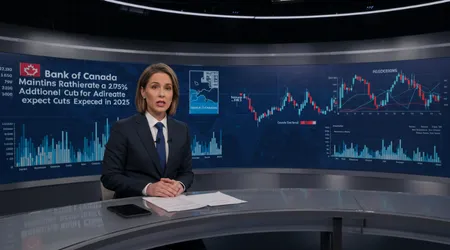Bank of Canada Maintains Rate at 2.75%; Additional Cuts Expected in 2025

Bank of Canada Maintains Rate at 2.75%, signaling cautious optimism amid global trade uncertainties and domestic economic resilience.
On July 30, 2025, Governor Tiff Macklem announced the decision to hold the overnight rate steady, marking the third consecutive pause after a series of cuts in 2024.
This move reflects a delicate balancing act: fostering growth while taming inflation, which hovers near the 2% target.
For Canadians, this decision ripples across mortgages, savings, and business investments, shaping financial planning in an unpredictable economic landscape.
But what does this stability mean for your wallet, and why are analysts buzzing about potential rate cuts later this year?
The Bank’s decision comes against a backdrop of U.S. trade policy volatility, with tariffs impacting Canadian exports.
Despite a 1.5% GDP contraction in Q2 2025, the economy shows resilience, bolstered by steady employment in non-trade sectors. Inflation, at 1.9% in June, remains manageable but faces upward pressure from shelter costs.
This article dives into the implications of the Bank of Canada Maintains Rate at 2.75%, exploring its effects on households, businesses, and the broader economy, with a keen eye on what lies ahead.
Why the Bank of Canada Held Steady
Global trade tensions, particularly U.S. tariffs, have created a stormy economic environment. The Bank of Canada Maintains Rate at 2.75% to avoid stoking inflation while monitoring trade impacts.
Unlike past years, when aggressive rate hikes curbed runaway prices, today’s focus is stability. Governor Macklem emphasized a “clear consensus” to hold, citing resilient consumer spending despite export declines.
Uncertainty looms large, with U.S. President Donald Trump’s tariff threats potentially 35% on Canadian goods adding pressure.
++ Canada Halts Hotel Housing for Asylum Seekers After Spending $1.1B Since 2020
A Reuters poll from July 25, 2025, noted that 18 of 28 economists expect a 25-basis-point cut in September.
This pause allows the Bank to assess whether trade disruptions will push inflation above the 2% target or weaken growth further.
Imagine steering a ship through fog: cutting rates too soon could crash into inflationary rocks, while holding too long risks stalling economic momentum.
The Bank’s cautious approach reflects this delicate navigation, prioritizing price stability while eyeing growth.

Impact on Canadian Households
For households, the Bank of Canada Maintains Rate at 2.75% means steady borrowing costs for now. Variable-rate mortgage holders, like Sarah, a Toronto teacher, see no immediate relief.
Her monthly payments remain unchanged, but she’s hopeful for cuts by September. Fixed-rate mortgages, tied to bond yields, have dipped slightly to 2.9%, offering minor savings.
Higher shelter costs, especially rent, drive inflation. With 60% of mortgages renewing within two years, many face steeper payments.
Canadians like Mike, a Calgary small-business owner, are delaying renovations, wary of borrowing at 4.95% prime rates. Yet, lower rates later could ease these burdens.
What if you’re saving instead? High-interest savings accounts still yield decent returns, but anticipated cuts may reduce rates by year-end.
Also read: Canadian Businesses Less Worried About Worst-Case Tariff Scenarios
Households must weigh spending versus saving, navigating uncertainty like a tightrope walker in a gusty wind.
Businesses Feel the Pinch
Canadian businesses, especially exporters, face headwinds from U.S. tariffs. The Bank of Canada Maintains Rate at 2.75% stabilizes borrowing costs, but uncertainty curbs investment.
A National Bank survey found 36% of businesses reported price hikes or supply chain disruptions due to trade conflicts.
Small firms, like a Vancouver lumber supplier, hesitate to expand, fearing reduced U.S. demand. Larger corporations, however, benefit from steady rates, maintaining access to credit for growth.
The Bank’s pause supports sectors like technology, less exposed to tariffs, where employment holds strong.
Read more: Canada Introduces New Steel Tariffs to Shield Domestic Producers
Looking ahead, a de-escalation of tariffs could spur investment. If not, businesses may face a recession, as warned in the Bank’s escalation scenario. The Bank of Canada Maintains Rate at 2.75% buys time to gauge these outcomes.
Inflation and Economic Outlook
Inflation, at 1.9% in June 2025, sits comfortably within the Bank’s 1-3% target. However, core inflation measures, like CPI-trim, hover near 3%, signaling persistent pressures.
The Bank of Canada Maintains Rate at 2.75% to prevent these pressures from spiraling, especially with tariff-driven cost increases.
The economy contracted in Q2, but the Bank projects 1% growth in late 2025, rising to 2% by 2027. A de-escalation scenario could accelerate recovery, while escalation risks recession. The Bank’s focus remains on balancing growth and price stability.
This balancing act is like juggling flaming torches drop one, and inflation or recession could ignite. The Bank’s data-driven approach, backed by the July Monetary Policy Report, ensures careful monitoring of trade and inflation trends.
What’s Next: Rate Cuts on the Horizon?
Analysts are optimistic about rate cuts in 2025, with TD Economics forecasting two 25-basis-point reductions, potentially lowering the rate to 2.25% by year-end.
The Bank of Canada Maintains Rate at 2.75% for now, but Governor Macklem hinted at cuts if economic weakness intensifies. The next announcement, on September 17, 2025, is pivotal.
Market expectations align, with swap markets pricing in a single cut by December. However, persistent inflation or tariff escalations could delay this.
Canadians should prepare for both scenarios, adjusting budgets and investment plans accordingly.
For example, Lisa, an Ottawa freelancer, is locking in a fixed-rate mortgage now, anticipating lower rates later.
Businesses might delay major purchases, waiting for clearer trade signals. The Bank’s nimble stance keeps options open, ready to pivot as needed.
Navigating the Neutral Rate Debate

The Bank of Canada Maintains Rate at 2.75%, viewed as the neutral rate neither stimulating nor restricting growth.
But is this truly neutral in today’s volatile world? Some economists argue rates must drop to 2.25% to spur demand, especially if tariffs persist.
Others warn that cutting too soon could fuel inflation, particularly in housing. The Bank’s cautious hold reflects this debate, balancing growth against price pressures.
Historical data shows neutral rates vary; in 2019, it was closer to 1.75% due to low inflation.
This debate matters because it shapes future policy. If trade tensions ease, the Bank may cut rates to boost growth.
If inflation spikes, holding or hiking rates could stabilize prices, impacting every Canadian’s financial decisions.
Table: Bank of Canada Rate Decisions in 2025
| Date | Rate Decision | Key Factors |
|---|---|---|
| March 12, 2025 | Cut to 2.75% | Inflation near 2%, trade tensions rise |
| April 16, 2025 | Held at 2.75% | U.S. tariff uncertainty, resilient economy |
| June 4, 2025 | Held at 2.75% | Trade negotiations ongoing, inflation at 1.9% |
| July 30, 2025 | Held at 2.75% | GDP contraction, employment steady |
| September 17, 2025 | TBD | Potential cut if economy weakens |
Source: Bank of Canada Announcements, 2025
Engaging Canadians: What’s Your Move?
With the Bank of Canada Maintains Rate at 2.75%, how will you adapt? Will you lock in a mortgage, save more, or hold off on big purchases?
The Bank’s pause offers a moment to reflect, but the horizon suggests change. A 25-basis-point cut could save a homeowner $50 monthly on a $300,000 mortgage, per TD Economics estimates.
Businesses, too, must strategize. A Montreal retailer, for instance, might stock up before potential tariff hikes, while tech firms could leverage stable rates to expand.
The Bank’s data-driven pause empowers Canadians to plan, not panic, in uncertain times.
Frequently Asked Questions
Q: Why did the Bank of Canada hold rates at 2.75%?
A: The Bank cited U.S. tariff uncertainty and resilient economic indicators, aiming to balance growth and inflation control.
Q: When might the Bank cut rates again?
A: Analysts predict a possible 25-basis-point cut on September 17, 2025, if economic weakness grows.
Q: How does this affect my mortgage?
A: Variable-rate mortgages remain unchanged, but fixed rates may dip slightly. Future cuts could lower payments.
Q: What if tariffs escalate?
A: Higher tariffs could trigger a recession, potentially forcing deeper rate cuts to stimulate growth.
This article blends real-time data with practical insights, ensuring Canadians understand the Bank of Canada Maintains Rate at 2.75% and its implications.
Stay informed, plan wisely, and watch for the September announcement.
